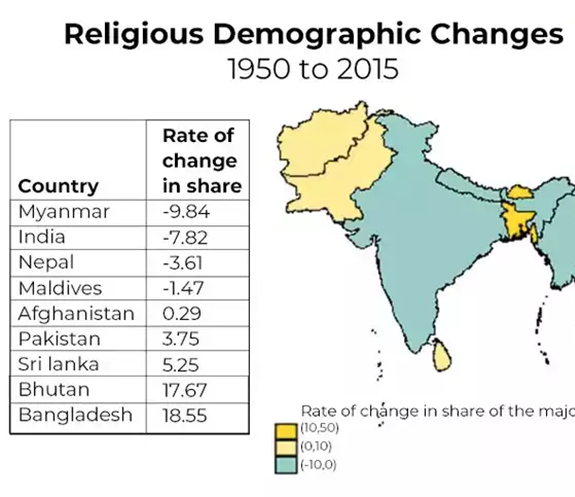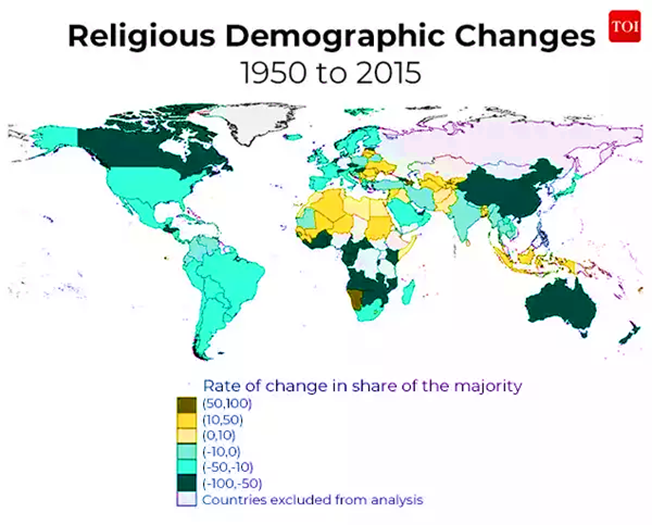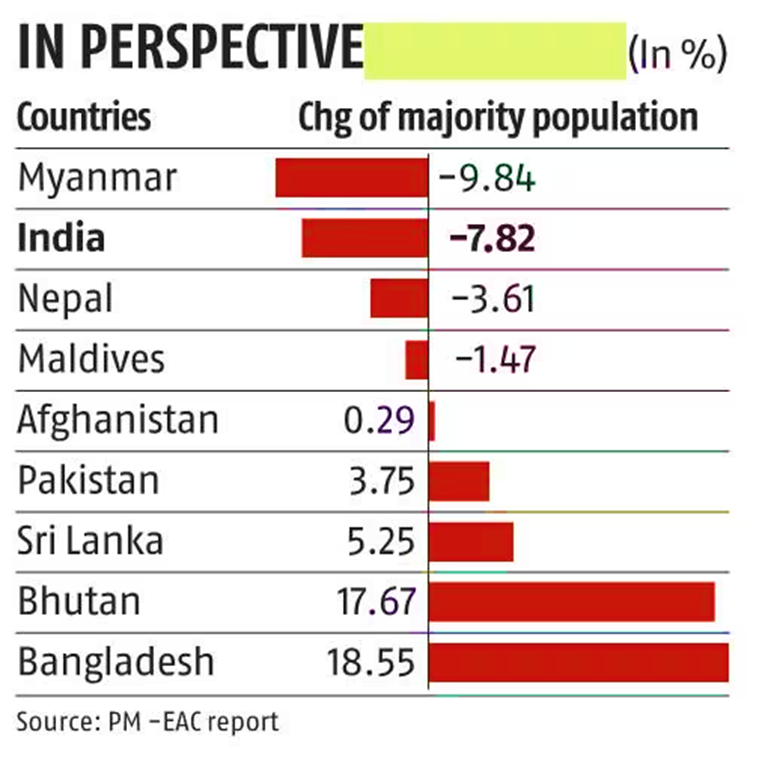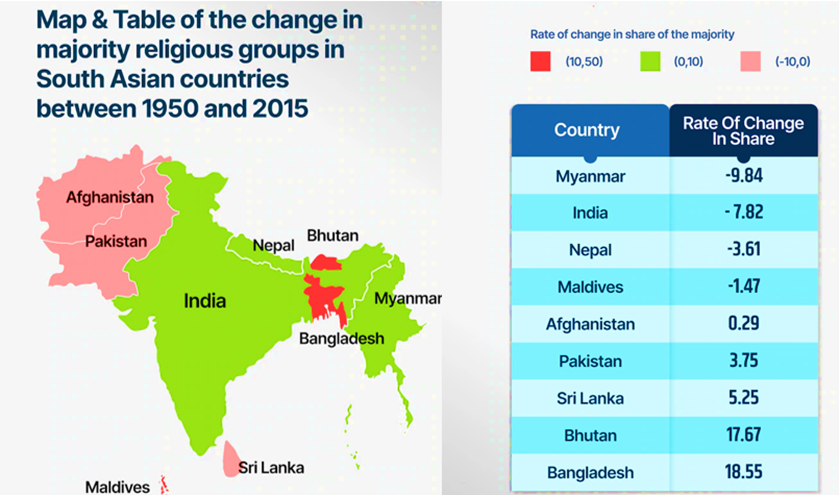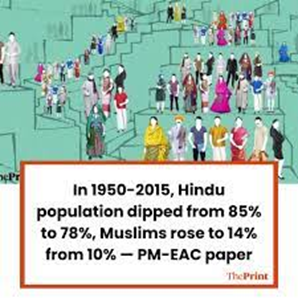A study by the Economic Advisory Council to the Prime Minister (EAC-PM) has revealed that the population share of the majority religion in India (Hindus) declined sharply by 7.8% between 1950 and 2015, while a number of neighbouring countries saw a jump in the population of their majority community.
Hindus’ Share In India’s Population Shrunk 8%
Why In News
- A study by the Economic Advisory Council to the Prime Minister (EAC-PM) has revealed that the population share of the majority religion in India (Hindus) declined sharply by 7.8% between 1950 and 2015, while a number of neighbouring countries saw a jump in the population of their majority community.
- While the Hindu population shrunk in India, the share of minorities, including Muslim, Christian, Buddhist and Sikhs, went up. However, the number of Jains and Parsis in the population mix decreased. This trend of decline in the majority population has also been seen in Nepal and Myanmar. However, 38 Islamic countries have seen an increase in the population of Muslims.
- According to the study, except for Parsis and Jains, the proportion of all other religious minorities, including Christians, Buddhists, and Sikhs, in India experienced an increase in their population share, reaching up to 6.58 per cent during this period.
Decline In Hindu Population In India
- The share of Hindus in India’s population saw a decrease from 84.68 per cent in 1950 to 78.06 per cent in 2015, while that of Muslims witnessed an increase from 9.84 per cent to 14.09 per cent in the same period, according to the EAC-PM study.
- “In India, the share of the majority Hindu population decreased by 7.82 per cent between 1950 and 2015 (from 84.68 per cent to 78.06 per cent). The share of the Muslim population in 1950 was 9.84 per cent and increased to 14.09 per cent in 2015 — a 43.15 per cent increase in their share,” says the working paper, Share of Religious Minorities: A Cross-Country Analysis (1950-2015), authored by Shamika Ravi, Apurv Kumar Mishra and Abraham Jose.
Minorities Grew In India
- While the Hindu population shrunk in India, the share of minorities went up between 1950 and 2015. The share of the Christian population rose from 2.24 per cent in 1950 to 2.36 per cent in 2015 (an increase of 5.38 per cent), the share of the population went up from 1.24 per cent to 1.85 per cent (a 6.58 percent point rise) for the Sikhs.
- Even the share of the Buddhist population witnessed a noticeable increase from 0.05 per cent in 1950 to 0.81 per cent.
- On the other hand, the share of Jains in the population of India decreased from 0.45 per cent in 1950 to 0.36 per cent in 2015.
- The share of the Parsi population in India witnessed a stark 85 per cent decline, reducing from 0.03 per cent share in 1950 to 0.004 per cent in 2015.
- “Contrary to the noise in several quarters, careful analysis of the data shows that minorities are not just protected, but indeed thriving in India. This is particularly remarkable given the wider context within the South Asian neighbourhood where the share of the majority religious denomination has increased and minority populations have shrunk alarmingly across countries like Bangladesh, Pakistan, Sri Lanka, Bhutan and Afghanistan,” the authors say.
Muslim Majority Increases In Pakistan, Bangladesh
- The paper also throws light on the global trend in the share of religious minorities and majorities in 167 countries over a period of 65 years.
- This trend of change in population is slightly different in a Muslim-majority country. According to the report released, the share of Muslims has increased in 38 Muslim-majority countries.
- “On the Indian subcontinent, all the Muslim majority countries witnessed an increase in the share of the majority religious denomination except Maldives where the share of the majority group (Shafi’i Sunnis) declined by 1.47 per cent,” it said.
- In Bangladesh, there was an 18 per cent increase in the share of the majority religious group which is the largest such increase in the Indian subcontinent. Pakistan witnessed an increase of 3.75 per cent in the share of the majority religious denomination (Hanafi Muslim) and a 10 per cent increase in the share of the total Muslim population despite the creation of Bangladesh in 1971.
- In 1950, Muslims accounted for 77.45 per cent of the population in Pakistan. Presently, Muslims in the neighboring country constitute 80.36 per cent. “Pakistan witnessed an increase of 3.75 per cent in the share of the majority religious denomination (Hanafi Muslim) and a 10 per cent increase in the share of the total Muslim population despite the creation of Bangladesh in 1971,” it said.
- Over the same period, Muslims in Bangladesh have increased from 74.24 per cent to 88.02 per cent of the population. Similarly, the Muslim population in Afghanistan has risen from 88.75 per cent to 89.01 per cent. However, in the Maldives, there has been a slight decline in the Muslim population, from 99.83 per cent to 98.36 per cent.
- As per the report, the population of Buddhists in Myanmar has decreased from 78.53 per cent to 70.80 per cent, the population of Buddhists in Sri Lanka has increased from 64.28 per cent to 67.65 per cent and the population of Buddhists in Bhutan has increased from 71.44 per cent to 84.07 per cent. However, on the other hand, in Nepal, the population of Hindus has decreased from 84.30 per cent to 81.26 per cent.
Conclusion
- The Referring to the global trends on increase and decrease in the share of the majority religious population, the authors said, “Our hypothesis is that the change in the proportion of the minority population as a share of total population is a good proxy for the status of minorities in a country over time. A society which provides a congenial environment for the flourishing of minorities is more likely to witness an increase or stabilization in their numbers over a period of three generations.”
- 20th ASEAN-India Summit & 18th East Asia Summit Highlights
- Manipur Police Register Criminal Case Against Assam Rifles
- Pakistan’s Ex-PM Imran Khan Jailed For 3 Years In ‘Toshakhana Case’
- Four Years After Removal Of Art 370: How Is The Actual Situation In Kashmir?
- Putin’s Critic Alexei Navalny Sentenced To 19 More Years In Prison
- Delhi Services Bill Tabled In Lok Sabha: Govt Of NCT Of Delhi (Amendment) Act, 2023
- Gurugram Nuh Violence: How A Religious Procession Turned Into A Communal Clash
- Govt Imposes Import Restrictions On Laptops, Tablets, Computers
- How Climate Change Is Altering The Colour Of The Oceans?
- New IPCC Assessment Cycle Begins: Why Is It So Significant?
- Difference Between NATO Vs Russia? [Explained]
- Italy Regrets Joining China Belt & Road Initiative (BRI)
- What Is Doping: Why Is It Banned In Sports?
- India Tiger Census 2023: India Is Now Home To 75% Of Tigers In The World
- Military Coup In Niger – President Detained, All Institutions Suspended
- No-Confidence Motion Against PM Modi’s Government
- Elon Musk’s SpaceX Rocket Punches Hole In Ionosphere
- Israeli Parliament Passes Controversial Law Stripping Supreme Court Of Power
- Significance Of 1999 Kargil War: How It Became A Major Game Changer For Indian Military?
- Controversy Over Movie Oppenheimer Gita Scene: How Are Films Certified In India?
- The Curious Case Of Qin Gang: China’s Foreign Minister Who Went Missing
- Twitter’s Iconic Blue Bird Logo Set To Be Replaced By An X Logo
- India Pulls Out Of Games In China Over Stapled Visas For Arunachal Athletes
- PM Modi Urges Sri Lanka President To Implement 13th Amendment
- India Pulls Out Of Games In China Over Stapled Visas For Arunachal Athletes
- Rajasthan CM Sacks Minister After Remarks Over Crimes Against Rajasthan Women
- Manipur Sexual Assault: Video Sparks Outrage Across The Country
- BRICS Summit 2023 In August: Why Putin Won’t Go To South Africa For The Summit?
- Robert Oppenheimer: The Father Of Atomic Bomb, Impact Of Bhagavad Gita On Him
- Russia-Ukraine Black Sea Grain Deal, Why Russia Has Halted It?
- Henley Passport Index 2023, India Passport Ranked 80th
- Indian Opposition Parties Form ‘INDIA’ Alliance, 26 Parties Unite For 2024
- Britain Joins Asia-Pacific Trade Group ‘CPTPP’ – Biggest Trade Deal Since UK Left EU
- NITI Aayog Report On National Multidimensional Poverty Index
- PM Modi UAE Visit: Highlights & Key Takeaways
- PM Modi’s Visit To France: Highlights & Key Takeaways
- NATO Summit Vilnius 2023: Highlights & Key Takeaways
- Turkey Supports Sweden’s Bid For NATO Membership At Vilnius Summit 2023
- Why ISRO Wants To Explore The Moon’s South Pole: Chandrayaan-3 Mission
- Bengal’s Panchayat Polls Turned Violent: SSB Interview Topic 2023
- First Ever IIT Campus Outside India In Tanzania
- RBI’s Report On “Internationalisation Of Rupee” Why And What Are The Benefits?
- Japan To Release Nuclear Wastewater Into Ocean – Gets Approval From IAEA
- PM Modi Chairs 23rd SCO Summit: Highlights & Key Takeaways
- Israel Raids Jenin Camp: Massive Military Operation In West Bank
- Dutch King Apologizes For Netherlands’ Role In Slavery: A Look At The Dutch Role In History
- Constitutional Crisis In Tamil Nadu: The Tussle Between Governor & DMK Government
- Why Has France Been Engulfed By Protests Again?
- Paris Summit – World Leaders Unite For A New Global Financing Pact
- India Ranked 67th On Energy Transition Index – Sweden On Top Of List By World Economic Forum
- Four Minor Planets Named After Indian Scientists
- NASA Recovers 98% Water From Urine & Sweat On ISS: Breakthrough In Long Space Missions
- ESA Space Telescope Euclid Is All Set For Launch To Observe Dark Side Of Universe
- PM Modi’s Trip To USA: Key Takeaways & Highlights
- PM Modi-Led Yoga Session Creates A New Guinness World Record
- Sajid Mir, The Mastermind Behind 26/11 – His Designation As Global Terrorist Blocked By China
- UN Adopts First Historic ‘High Seas Treaty’ To Protect Marine Life
- International Yoga Day 2023 – How It Was Celebrated Across The World?
- Gender Apartheid – Why Is Afghanistan At Stand Off With UN?
- Gandhi Peace Prize 2021 For Gita Press Why It Triggered A Congress-BJP Brawl?
- The New Pride Flag – Why The Change & What The Colours Signify?
- 48 Years Of Emergency – PM Modi Refers It As India’s Darkest Period In Mann Ki Baat
- Groundwater Extraction Has Tilted Earth’s Spin – How Will It Impact The Climate Change?
- Europe’s Worst Migrant Boat Disaster – 78 Dead, Hundreds Missing Off Greek Coast
- MOVEit Global Hacking Attack – Government Agencies In The USA Targeted
- Karnataka Govt Decides To Repeal Anti-Conversion Law: Why Was The Law Controversial?
- IIT Bombay Among Top 150 Varsities In QS Rankings 2024
- China’s Xi Jinping Backs ‘Just Cause’ Of Palestinian Statehood – Chinese Middle Eastern Diplomacy
- Turkey Won’t Back Sweden’s Bid To Join NATO – Why Is Erdogan Against Sweden’s Application
- UN Report Reveals Chronic Bias Against Women – 25% Of Population Thinks Beating Wife Justifiable
- Zinnai – Space Flower Grown On International Space Station By NASA – Why Is It Significant?
- Who Are Meira Paibis: Manipur’s ‘Torch-Bearing’ Women Activists?
- USA Set To Re-Join UN Cultural Agency UNESCO




